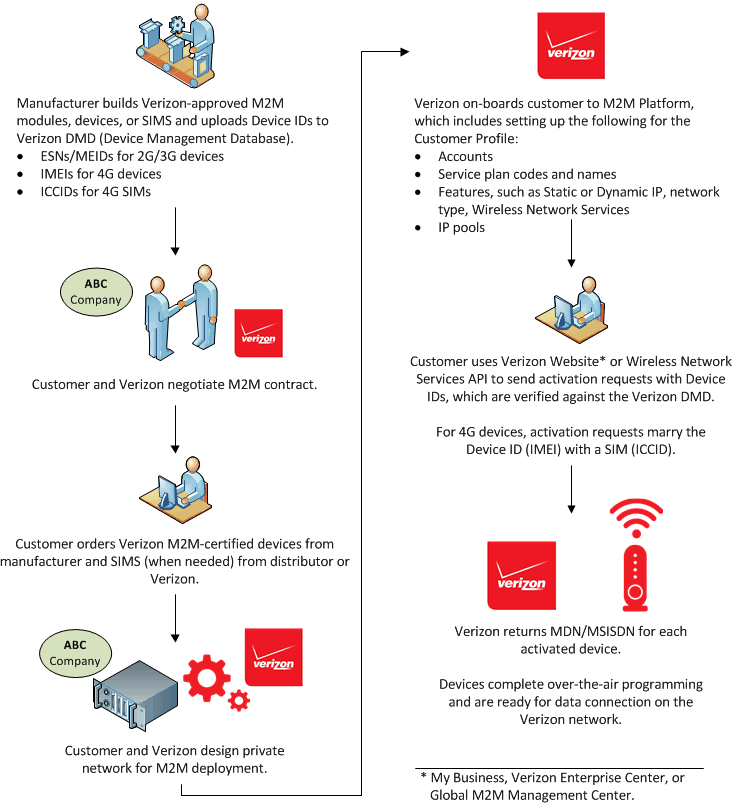
Verizon employs numerous identifiers to name the devices on its network, which can be confusing when you are configuring an M2M deployment. This article shows where IDs originate, from manufacturer to the point when they are provisioned on the Verizon network. It then explains the IDs used for 2G/3G M2M devices vs. 4G M2M devices.

ESNs were assigned to CDMA devices by their manufacturers up to about 2006. An ESN uniquely identifies a device. It is transmitted to the network each time the device is used to verify that the device has not been reported lost or stolen and that all subscriber bills are current.
ESNs were administered by the Telecommunications Industry Association (TIA), which assigned a code to each device manufacturer to prepend to the actual serial number, which the manufacturer controlled. An 11-digit ESN is composed of the manufacturer’s code, represented in the first 3 digits, and serial number of the device, which makes up the remaining eight digits.
As manufacturers produce certified Verizon devices, they upload identifiers, including ESNs, to the Verizon Device Management Database (DMD), where they await activation by an approved account (see M2M Service Provisioning Rules).
After the ESN supply was exhausted, the TIA devised the MEID system for CDMA device manufacturers to use to identify 3G devices. Like the ESN, an MEID is transmitted to the network each time its device is used to verify that the device has not been reported lost or stolen and that all subscriber bills are current.
The following three pieces of data are represented in an MEID’s 14 hexadecimal characters:
As manufacturers produce certified Verizon devices, they upload identifiers, including MEIDs, to the DMD, where they await activation by an approved account (see M2M Service Provisioning Rules).
Verizon uses a 10-digit MIN to internally track and route traffic to/from a device. The MIN of a device is transmitted to the network each time the device is used to verify that the phone has not been reported lost or stolen and that all subscriber bills are current.
Traditionally, only 3G devices are assigned MINs; however, because 4G devices contain components to also allow 3G traffic, they too have MINs.
An IMEI is the unique identifier assigned by the manufacturer to the radio module in a 4G device. An IMEI is the main identifier for a 4G device, but every 4G device also contains a SIM card that is identified by an ICCID. A 4G device must have a SIM card to be active on the Verizon Wireless network, and you can can usually consider them as a single unit, and you can use either the IMEI or the ICCID to refer to the acive device. For devices with removable SIM cards, though, it is important to keep in mind that the SIM can be replace with a different one, or the existing SIM can be put in a different device, so one of the identifiers may change.
Most 4G devices also have a 3G modem to allow communication when a 4G connection isn’t available. These devices have both MEID and IMEI identifiers that are recognized by the Verizon network; however, the IMEI is the primary identifier.
As manufacturers produce certified Verizon devices, they upload identifiers, including IMEIs, to the Verizon DMD, where they await activation by an approved account (see M2M Service Provisioning Rules.
Every 4G M2M device requires a SIM card, which enables it to communicate on a wireless network. SIM cards are made to operate on a certain carrier’s network. Therefore, SIM cards manufactured to enable communication on the Verizon network are different from those built to communicate on other carriers’ networks.
This identifier is the unique serial number assigned to and physically imprinted on a SIM card by the manufacturer. An ICCID is stored in a SIM card’s memory and never changes over the life of the card.
You can remove a SIM card from a device and insert it into another device. The ICCID remain with the SIM, but the SIM is paired with the IMEI of the new device.
You can put devices in groups in order to perform operations on multiple devices at one time.
Custom fields for devices are optional. They are usually used to categorize, identify and track devices. These fields can represent regions, business units, device types and models, or any other information that is helpful in categorizing, identifying, sorting and monitoring devices.